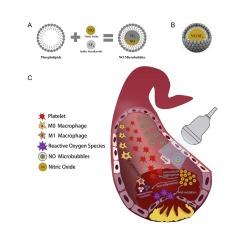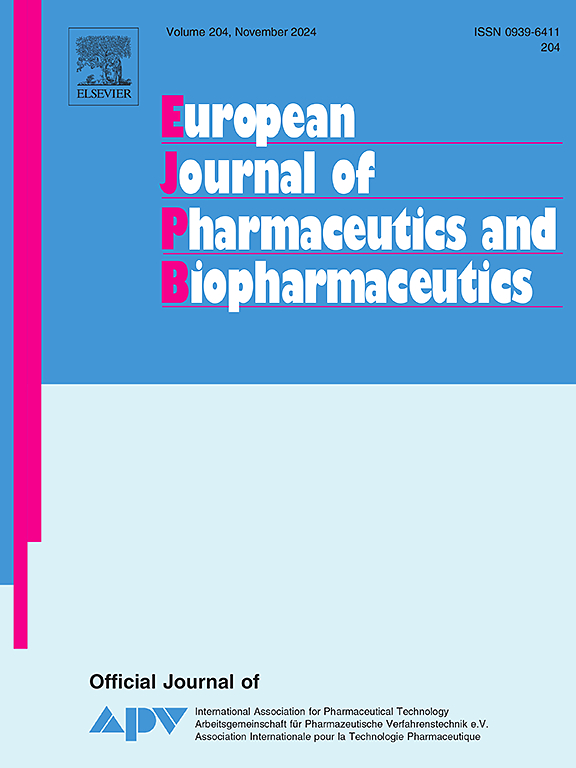利用 NO-MBs UTMD 疗法加速动脉血栓溶解。
IF 4.4
2区 医学
Q1 PHARMACOLOGY & PHARMACY
European Journal of Pharmaceutics and Biopharmaceutics
Pub Date : 2024-10-28
DOI:10.1016/j.ejpb.2024.114566
引用次数: 0
摘要
动脉血栓性疾病是一种常见而严重的临床医学问题。一氧化氮(NO)作为一种治疗气体,可以延缓血栓形成的进展,减轻组织缺血缺氧损伤。然而,NO 的全身给药会引起并发症,而且体内的 NO 很容易被血液中的血红蛋白清除。在这项研究中,我们设计了一种携带 NO 的脂质微泡(NO-MBs),并结合超声靶向微泡破坏(UTMD)技术,在实时造影剂增强超声监测下实现 NO 的靶向输送。通过检测NO-MB的直径、浓度和造影剂增强超声强度随时间的变化,证明了其良好的稳定性。此外,体内和体外溶栓实验证实,NO-MB 和 UTMD 的结合可加速动脉溶栓。同时,检测了治疗后血管组织中炎症因子、超氧化物歧化酶(SOD)和丙二醛(MDA)的水平,结果表明 NO-MBs 能显著减轻血栓栓塞引起的炎症反应和氧化应激。此外,为了评估 NO-MBs UTMD 治疗策略的安全性,研究人员还进行了 MTT 试验、溶血试验、血清生化指标检测和主要器官的 H&E 染色。结果表明,这种治疗策略具有良好的生物安全性。总之,NO-MBs UTMD 治疗策略在治疗动脉血栓性疾病方面具有巨大潜力。本文章由计算机程序翻译,如有差异,请以英文原文为准。

Accelerating thrombolysis of arterial thrombus with NO-MBs UTMD therapy
Arterial thrombotic disease is a common and serious clinical medical problem. Nitric oxide (NO), as a therapeutic gas, can delay the progression of thrombosis and reduce tissue ischemia and hypoxia damage. However, systemic delivery of NO causes complications, and NO in the body is easily cleared by hemoglobin in the blood. In this study, we designed a lipid microbubble carrying NO (NO-MBs) combined with ultrasound-targeted microbubble destruction (UTMD) technology to achieve targeted delivery of NO under real-time contrast-enhanced ultrasound monitoring. The good stability of the NO-MBs was demonstrated by examining the changes in diameter, concentration and contrast-enhanced ultrasound intensity with time. Moreover, in vivo and in vitro thrombolysis experiments, it was confirmed that the combination of NO-MBs and UTMD could accelerate arterial thrombolysis. Meanwhile, the levels of inflammatory factors, superoxide dismutase (SOD) and malondialdehyde (MDA) in vascular tissue after treatment were detected, which showed that NO-MBs could significantly reduce the inflammatory response and oxidative stress induced by thromboembolism. In addition, so as to evaluate the safety of the NO-MBs UTMD treatment strategy, MTT assay, hemolysis test, detection of serum biochemical indicators, and H&E staining of major organs were performed. The results showed that this treatment strategy had excellent biosafety. In conclusion, the NO-MBs UTMD treatment strategy has great potential in the treatment of arterial thrombotic diseases.
求助全文
通过发布文献求助,成功后即可免费获取论文全文。
去求助
来源期刊
CiteScore
8.80
自引率
4.10%
发文量
211
审稿时长
36 days
期刊介绍:
The European Journal of Pharmaceutics and Biopharmaceutics provides a medium for the publication of novel, innovative and hypothesis-driven research from the areas of Pharmaceutics and Biopharmaceutics.
Topics covered include for example:
Design and development of drug delivery systems for pharmaceuticals and biopharmaceuticals (small molecules, proteins, nucleic acids)
Aspects of manufacturing process design
Biomedical aspects of drug product design
Strategies and formulations for controlled drug transport across biological barriers
Physicochemical aspects of drug product development
Novel excipients for drug product design
Drug delivery and controlled release systems for systemic and local applications
Nanomaterials for therapeutic and diagnostic purposes
Advanced therapy medicinal products
Medical devices supporting a distinct pharmacological effect.

 求助内容:
求助内容: 应助结果提醒方式:
应助结果提醒方式:


